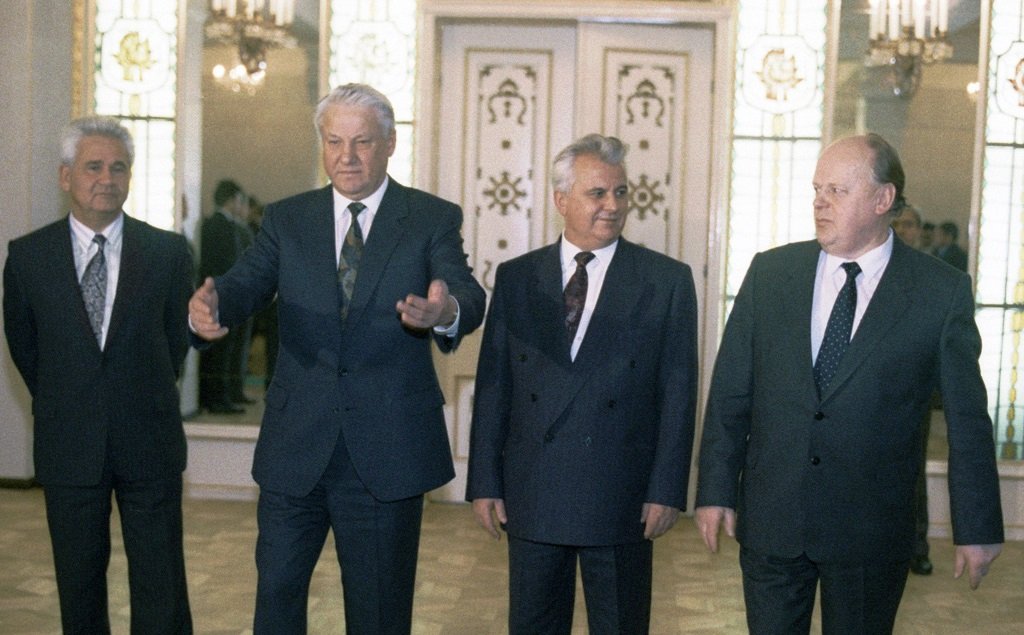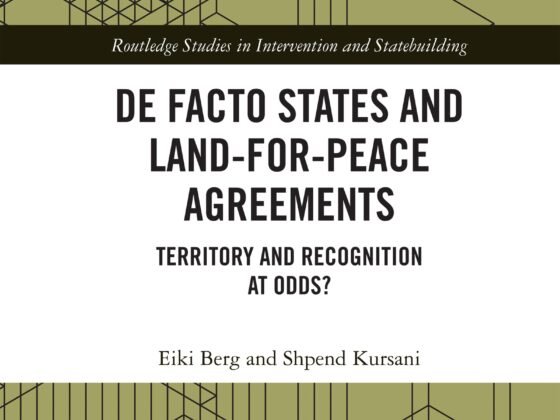(PONARS Eurasia Policy Memo) As this year draws to a close, Russia and most of the former Soviet states will mark three decades since the USSR was dissolved and a new entity emerged in its place: the Commonwealth of Independent States (CIS). The so-called Belavezha Accords between the three “Slavic” Soviet Republics of Russia, Ukraine, and Belarus proclaimed that the USSR ceased to exist as a subject of international law on December 8, 1991. Eight other former Soviet Republics joined the three signatories in what became known as the Alma-Ata Accords on December 21 that formally established the CIS.
The end of the Cold War also heralded an onset of another period: the beginning of post-Soviet institution-building and institutionalized cooperation between sovereign post-Soviet states. Russia would lead most, albeit not all, of these processes. Some would ultimately go beyond the institutionalization of cooperation within just the former Soviet space. For instance, the Shanghai Cooperation Organization (SCO) would encompass China and later also India and Pakistan. In September 2021, plans were announced to promote Iran as a full-fledged member. Rather than Russia, China was, in the words of Chinese scholar Zhao Huasheng, the leading “agitator” behind the SCO’s establishment.
The post-Soviet space would also see the creation of other regional bodies that did not include Russia, although Russia was nonetheless an object of their attention. For instance, the Organization for Democracy and Economic Development (or GUAM) comprises the former CIS members of Georgia and Ukraine (mostly withdrawn) as well as the two active CIS members of Azerbaijan and Moldova. As the CIS grew ineffective due to the suspicions and diverging ambitions between its members, Russia reframed its approach, but all ensuing bodies—Collective Security Treaty Organization (CSTO), Shanghai Cooperation Organization (SCO), and Eurasian Economic Union (EAEU)—ran out of steam. Instead of working on overcoming problems inside of the original projects, Moscow has been turning its attention to another project, the Greater Eurasia Partnership.
The Divisive Legacy of the CIS
While the CIS was the oldest of the post-Soviet integrative projects, it would, as Richard Sakwa wrote, become “an unloved child of the break-up of the Soviet Union.” First, the Commonwealth would face a difficult path and would be largely dismissed as a failed project. Its problems included a considerable discrepancy between the signing of numerous agreements and their meager rate of implementation. Second, Russia as a de-facto leader and by far the most powerful state was viewed with an understandable degree of suspicion by smaller CIS partners, which suffered from separatist movements on their territory, some of which were backed by Russia. These states would go on to form GUAM, which has been described by scholars such as Barry Buzan, Ole Wæver, and Sakwa as the region’s real balancing organization, with a function of opposing Russia’s hegemony in addition to advocating for declarative if not always observed objectives such as strengthening democratic values, supremacy of the law, and respect for human rights.
There was also the broader problem of Russia’s genuine commitment to the CIS, which, while being envisioned as an integration tool, did not receive Russia’s full backing in the 1990s. Scholars Andrej Krickovic and Maxim Bratersky point out how Russia withdrew from the ruble zone in 1992, which seriously undermined the region’s economic integration. It is worth noting that despite all the pessimistic prognoses, the CIS was not disbanded. In Russia, the official discourse on the CIS is optimistic and emphasizes the high interest and richness of cooperation in industry and humanitarian affairs. Some scholars point out that, in fact, its oft-criticized institutional design was given organizational flexibility to allow the interaction between states despite the fears of Russia’s dominant power. Hence, while sacrificing integration, CIS institutions allowed for constructive cooperation between sovereign successor states.
Ultimately, however, Russian leadership sought a functioning institutionalized cooperation that would result in integration. There were practical impulses for pursuing this. In the security area, the region experienced interstate and intra-state violence following the break-up of the Soviet Union, drug trafficking, terrorist threat, and other issues. The weaker CIS members struggled to deal with this independently and sought integration with and support from Russia. From an economic point of view, leaders in Moscow recognized that Russia’s survival as a great power depended on regional integration and pursuit of other economic models rather than over-reliance on the export of hydrocarbons. The 2008-09 global financial crisis reinforced these views. In a way, the CIS’ inability to facilitate this served as a spur that led to a more pragmatic take on cooperation. In its 2000 foreign policy concept, Russia noted differences in speed and level of integration within the Commonwealth. It was, thus, decided that it would re-focus on those integrative projects that produced narrower associations with partners who were willing to follow its lead.
The CSTO’s Credibility Problem
The states interested in re-forging closer military-security cooperation with Russia established the Collective Security Treaty Organization (CSTO) in 2002. At the regional level, this organization would serve Russia as a tool of institutionalized cooperative hegemony, where Moscow offered power-sharing and side payments to other members in exchange for their participation and legitimization of Russia’s role. In practical terms, apart from symbolic dominance, Russia and its partners needed the CSTO to work together to address shared concerns such as transnational terrorism, drug trafficking, the proliferation of WMDs, uncontrolled migrations, as well as the presence of foreign troops. Russia was also interested in limiting NATO’s role in the region by ensuring that it could not expand to incorporate new members among former Soviet Republics or place its troops on their territory without Moscow’s approval. CSTO integration was also seen as an effort to reinforce the stability and legitimacy of the existing governments.
However, the CSTO is essentially an untested, unproven, and ultimately a stagnating project. It seems to have reached its enlargement potential with six members: Russia, Belarus, Kazakhstan, Armenia, Kyrgyzstan, and Tajikistan. It has not added a new member since 2006 when Uzbekistan rejoined (only to leave it again in 2012). The only additions were Afghanistan and Serbia, which became observers to the CSTO Parliamentary Assembly in 2013. Over the years, the CSTO developed a capable multinational force called Collective Rapid Reaction Forces of about 18,000 troops officially (or 25,000 according to expert analysis), which engage in frequent drills. This led one prominent security analyst to label the CSTO as “the most important multilateral defense structure in the former Soviet Union.” However, the organization has been paralyzed and unable to act during several crises that engulfed its members.
The CSTO missed opportunities to use some of its joint tools to test its capabilities and gain some visibility, as I argued last year. It could have deployed peacekeepers during the 2020 Nagorno-Karabakh conflict, but the Russian leadership chose to act bilaterally. The CSTO’s failure to act was a bitter disappointment to Armenia, which had been supportive of it and dependent on its assistance given its complex geopolitical situation. It led a Russian commentator to declare how the CSTO was essentially lacking in popularity, given that most people were unaware of its existence. Then in the summer of 2021, following the rapidly deteriorating situation in neighboring Afghanistan, Tajikistan first mobilized 20,000 of its reservists and sent them to the border and then formally requested assistance from CSTO allies. With the fall of Kabul to the Taliban, Tajikistan became even more concerned, and Russia initiated further drills that included Kyrgyzstan, Tajikistan, and non-CSTO Uzbekistan. The ongoing crisis could indeed offer some form of redemption to the CSTO to prove its utility to its members.
An Incomplete Project: EAEU
Regarding economic integration, Russia and a select few of its CIS partners had a similar mindset. In 2000, the Eurasian Economic Community (EurAsEC) was established to reintegrate the region economically by forming a trade bloc, common customs, and tariff and non-tariff duties. Still, it came up short of its expectations. Following a narrower format, Russia, Kazakhstan, and Belarus formed the Customs Union in 2009, further expanding to include a common economic space in 2012. These processes increased the trade between the three states considerably—by seventy percent from 2009 to 2011—and the project was later transformed into the Eurasian Economic Union (EAEU) in January 2015. Armenia and Kyrgyzstan would join the three, and Tajikistan remained an aspiring member. Uzbekistan and Cuba were added as observers in 2020; however, Russia would prefer if the former were a full-fledged member. Moscow is particularly disappointed by the absence of Ukraine, which makes the project incomplete.
Even without Uzbekistan, the EAEU had a rocky start given worsening ties between Russia and the West, which sanctioned it over its actions in Ukraine. Moreover, this was coupled with a drop in global prices of hydrocarbons, which led to a contraction of the Russian economy by 3.7 percent in 2015. Given the sheer size and dependence of others on Russia, these negative trends impacted the performance and benefits of the EAEU. Mutual trade kept declining and rebounding as economic difficulties continued, Russia’s economy was sluggish in recovering, and the EAEU’s growth lagged behind global trends. Furthermore, the Union was an inadequate mechanism for responding to the more significant challenge of China’s economic clout across the former Soviet space, given that many EAEU members made bilateral deals to benefit from China’s Belt and Road Initiative.
The SCO’s Divisive Path
Beyond these bodies, Russia’s institution-building in the former Soviet space has also included the Shanghai Cooperation Organization. However, this was primarily a China-led project. Moscow was treated as an equal co-leader, and its participation was essential for the development of the SCO. However, while the organization had successfully settled the mutual boundaries and de-militarized border areas of its original core five founding members—China, Russia, Kazakhstan, Kyrgyzstan, and Tajikistan—and had later established intelligence sharing for countering terrorism, its further evolution has stagnated since the mid-2000s. Russia’s role in this process had also been crucial given the discrepancy between its vision for the SCO and that of China.
While the latter sought to add a free trade dimension to the repertoire of SCO competencies, which would formalize its dominant economic position, Moscow had little interest in this. Instead, it saw the SCO as a new emerging non-Western center of power that competed with the U.S.-led one and where Russia would be one of the main players. Moreover, Russia realized its disadvantaged position vis-à-vis China and had no desire to empower the SCO, which might replace Russian-led projects like the CSTO and EAEU. To overcome this stalemate, the two agreed to the expansion of the SCO’s membership to include India and Pakistan in 2017, thus fundamentally changing the organization’s focus on Central Asia. It announced further enlargements in 2021 to add a Middle-Eastern state—Iran—thus further expanding the organization’s clout.
The impact this decision has on the SCO will be seen in the next few years. It will also show Russia’s true intentions behind the push for enlargement. Is Moscow merely pursuing such a policy to weaken China’s influence in Central Asia by “diluting” its organization with questionable enlargement, or does Russia have a genuine interest in forming a competent non-Western center of influence? If the latter is to become possible, the SCO will have to overcome considerable internal divisions and disputes among some of its members, such as between India and Pakistan or even between India and China, and diverging views on relations with the West.
A “Greater Eurasia” Distraction
Since 2015, certain Russian scholars, led by prominent foreign policy thinker Sergei Karaganov and top Russian officials, discussed even more ambitious concepts such as the Greater Eurasia Partnership. It is a project with no fixed institutional setting, a grandiose vision, and scant details. Karaganov describes it as a “future-oriented geopolitical, geo-economic, and civilizational (or geo-ideological) project.” Indeed, apart from striving for more idealistic goals such as promoting peace, cooperation, and inter-civilization dialogue, the thinkers behind this project position it as a geopolitical concept that will arise and be parallel to what Karaganov calls “Greater America.” Greater Eurasia was intended to unite Russia, China, Central Asia, and possibly other Asia states like India, Pakistan, and Iran, creating a new geopolitical space. The project inevitably reveals some of Russia’s frustrations with the post-Cold War settlement. Hence, this new geostrategic community is slated to “overcome the rifts left by the previous Cold War.” Unsurprisingly, among the key tenets are the principles that Russia has consistently reiterated during its disputes with the West—unconditional respect for political pluralism, sovereignty, territorial integrity, and so forth—even though it has not always observed them itself.
Clearly, Russia seeks to present the Greater Eurasia Partnership as an alternative to the U.S.-led order. Moreover, China is portrayed as an integral part of it, and Russian thinkers posit that immersing it inside the project will protect China from “being seen [as] a potential hegemon.” The project cannot yet be considered an institutional one as it does not have a clear foundation, albeit Karaganov thought that the SCO was a natural platform for it. This might explain some of Russia’s interest in the expansion of this organization. However, no details were given regarding how it would be done. In fact, some scholars argue that the lack of clarity and blurred nature of the project is not just due to it still being a work in progress but also an intentional attempt to gain interest given its flexible interpretation. In the words of one expert, the appeal to Russia is that Greater Eurasia offers “abundant opportunity while imposing few obligations.”
Conclusion
At the turn of three decades, since the CIS was established, Russian policymakers can look at Eurasia with some dose of satisfaction. Their country helped establish four recognizable regional organizations. While each had to be painstakingly developed before it was able to attain a minimum of its objectives, today they all find important roles in Russia’s official foreign policy concepts of the last decade and more. Success aside, some of these bodies seemed to have reached their growth potentials and slipped into stagnation, while others like EAEU had been undermined from the onset. Russia could indeed focus on improving and repairing them and ultimately making them better. However, rather than working to overcome obstacles for their further growth, Russia’s policy seems to have moved once again to newer and even more ambitious projects like the Greater Eurasia Partnership. It reveals Russia’s never-ending obsession with larger geopolitical projects that it believes are part of the greater competition with the West and will supposedly maintain its declining influence not only globally but also regionally.
Janko Šćepanović is a Postdoctoral Researcher in the School of Advanced International and Area Studies at the East China Normal University, Shanghai, China.
PONARS Eurasia Policy Memo No. 726











